

Groundwater is mostly non-renewable, study finds. The water that supplies aquifers and wells that billions of people rely on around the world is, from a practical perspective, mostly a non-renewable resource that could run out in many places, a new Canadian-led study has found.
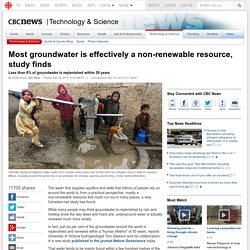
While many people may think groundwater is replenished by rain and melting snow the way lakes and rivers are, underground water is actually renewed much more slowly. In fact, just six per cent of the groundwater around the world is replenished and renewed within a "human lifetime" of 50 years, reports University of Victoria hydrogeologist Tom Gleeson and his collaborators in a new study published in the journal Nature Geoscience today. That water tends to be mainly found within a few hundred metres of the surface, where it is most vulnerable to being contaminated by pollution or depleted by higher temperatures and reduced rainfall as a result of climate change, the researchers found. Nuclear clues His team came up with almost exactly the same number. How to fix California's drought problem—commentary. A dilapidated city park was remodeled with cisterns below, as were medians along broad boulevards that were themselves underwater during heavy rains.

The result was a system, using ancient Roman technology (see photo above), that captures 8,000 acre feet of water each year, about twice what the entire city consumes, solving the flooding problem and creating a source of fresh water for thousands of residents. The investment also gave the city a new park with ball fields and picnic grounds and higher adjacent property values. Brazil's most populous region facing worst drought in 80 years. 23 January 2015Last updated at 21:32 ET Sao Paulo state has received only one third of the rainfall expected in the wet season.

Drought Drains Lake Mead to Lowest Level as Nevada Senator Calls for Government Audit. As the largest reservoir in the U.S. falls to its lowest water level in history, Nevada State Sen.
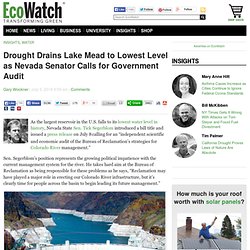
Tick Segerblom introduced a bill title and issued a press release on July 8 calling for an “independent scientific and economic audit of the Bureau of Reclamation’s strategies for Colorado River management.” Sen. Segerblom’s position represents the growing political impatience with the current management system for the river. He takes hard aim at the Bureau of Reclamation as being responsible for these problems as he says, “Reclamation may have played a major role in erecting our Colorado River infrastructure, but it’s clearly time for people across the basin to begin leading its future management.” Further, the Senator calls for a more environmentally minded management focus on the health of the river as stated in his press release: “Healthy rivers signal healthy societies, yet Reclamation failed to mention ecological issues in its recent analysis.
Whether you agree or disagree with Sen. Egypt, Ethiopia and Sudan sign deal to end Nile dispute - BBC News. Three African leaders have signed an initial deal to end a long-running dispute over the sharing of Nile waters and the building of Africa's biggest hydroelectric dam, in Ethiopia.

The leaders of Egypt, Ethiopia and Sudan signed the agreement in Sudan's capital, Khartoum. Egypt has opposed the Great Ethiopian Renaissance Dam, saying it would worsen its water shortages. Ethiopia says the dam will give it a fairer share of Nile waters. In 2013, Ethiopia's parliament ratified a controversial treaty to replace colonial-era agreements that gave Egypt and Sudan the biggest share of the Nile's water. Egypt's then-President Mohamed Morsi said he did not want war but he would not allow Egypt's water supply to be endangered by the dam. Mr Morsi's successor, Abdul Fattah al-Sisi signed the deal with Ethiopia's Prime Minister Halemariam Desalegn and Sudan's President Omar al-Bashir. Mr Sisi said the project remained a source of concern to Egypt. Fact Sheet 2014–3098: Climate Change: Evaluating Your Local and Regional Water Resources.
The Basin Characterization Model Ongoing changes in climate, particularly rises in air temperature, are influencing water resources throughout the world, with shifts in the timing of precipitation, reductions in snowpack (fig. 1), and earlier springtime snowmelt among the most important challenges to water availability (fig. 2).

These changes are affecting landscapes, vegetation and animal species, and agriculture, with longer dry seasons, which also create more demand on water resources, more frequent extreme storms, fewer chilling hours, and higher snowlines. Figure 1. Change in snow water equivalent (SWE) between 1951–1980 and 1981–2010 in California. These decreases in snowpack reflect world-wide trends in all but the highest elevations over the last half-century. Figure 2. Glaciers melting under continuous warming endangering Asian drinking water resource: study. GNN Podcast: ETHIOPIA’S DAM PROBLEMS. Posted on July 1, 2014 by Editor Ethiopia is three years from completing a dam to control its headwaters, and while Egypt points to colonial-era treaties to claim the water and to stop the project, the question remains as to who owns the Blue Nile more… Like this: Like Loading...
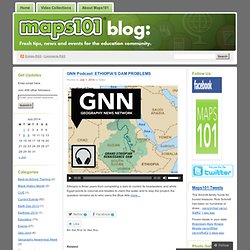
Filed under: Current Events, Education, Podcast Tagged: | Blue Nile River, Egypt, Ethiopia, Grand Ethiopian Renaissance Dam, Sudan. Grow lights and drones: How California’s drought is driving farmers into high-tech. OROVILLE, CA - AUGUST 19: A section of Lake Oroville is seen nearly dry on August 19, 2014 in Oroville, California.

As the severe drought in California continues for a third straight year, water levels in the State's lakes and reservoirs is reaching historic lows. Lake Oroville is currently at 32 percent of its total 3,537,577 acre feet. (Photo by Justin Sullivan/Getty Images) California's grappling with one of its worst droughts in history. Iraq crisis: How Islamic State could exploit the Mosul Dam.
13 August 2014Last updated at 10:46 ET By Alex Milner BBC News.
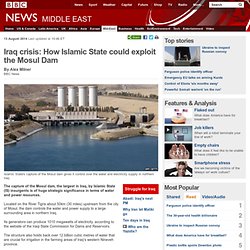
Loss of Snowpack and Glaciers In Rockies Poses Water Threat by Ed Struzik: Yale Environment 360. 10 Jul 2014: Report by ed struzik When Rocky Mountain explorer Walter Wilcox hiked up to Bow Summit in Canada’s Banff National Park in 1896, he took a photo of a turquoise lake that later caught the eye of a National Geographic magazine editor.
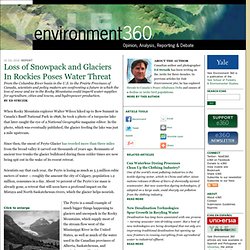
Mapping the Spread of Drought Across the U.S. The Last Drop: America's Breadbasket Faces Dire Water Crisis. Editor's note: This story is one in a series on a crisis in America's Breadbasket –the depletion of the Ogallala Aquifer and its effects on a region that helps feed the world. VEGA, Texas–While a high-pitched wind rattles the windows, and assaults a flapping, fraying American flag in the front yard, Lucas Spinhirne knows he’s staring into an abyss that many in Texas—and across the world—may be forced to contemplate. The once bounteous quantities of water that flowed under his farmland in the Texas Panhandle are a distant memory–pumped to the last drop. Now there is only one source of water for his wheat and sorghum: the sky above. “We try to catch anything that falls,” Spinhirne says. The United States of drought.
Water supply key to outcome of conflicts in Iraq and Syria, experts warn. The outcome of the Iraq and Syrian conflicts may rest on who controls the region’s dwindling water supplies, say security analysts in London and Baghdad. Rivers, canals, dams, sewage and desalination plants are now all military targets in the semi-arid region that regularly experiences extreme water shortages, says Michael Stephen, deputy director of the Royal United Services Institute thinktank in Qatar, speaking from Baghdad.
“Control of water supplies gives strategic control over both cities and countryside. We are seeing a battle for control of water. Where Has All the Water Gone? Once the fourth-largest lake in the world, Central Asia’s shrinking Aral Sea has reached a new low, thanks to decades-old water diversions and a more recent drought. (National Geographic News) Use our resources to better understand this ongoing environmental catastrophe. The Aral Sea was once the world’s fourth-largest lake.Image by NASA (left) and NASA Earth Observatory image by Jesse Allen, using data from the Level 1 and Atmospheres Active Distribution System (LAADS) Discussion Ideas According to our media spotlight “Disappearing Lake,” the Aral Sea has always been a saline (salty) lake, but it has become much saltier as its waters have receded.
NG Article: Aral Sea’s Eastern Basin Is Dry for First Time in 600 Years NG Media Spotlight: Disappearing Lake NG Encyclopedic Entry: basin (page 2: endorheic basin) Wikipedia article: Salar de Uyuni (salt flat) NG Photo: Dead Sea NG Photo Gallery: 8 Mighty Rivers Run Dry From Overuse USGS Photo Gallery: Lake Chad, West Africa.